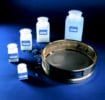How to Calibrate Test Sieves
Article
The heightened interest in improving the quality control of test-sieving programs is, in part, the result of increasing pressures for ISO 9000 certification.
Almost daily, we are asked the question:
HOW DO I CALIBRATE MY TEST SIEVES?
There are two common recognized ways to calibrate test sieves:
- Conduct calibration tests using glass spheres.
- Physically examine each sieve using microscopic projection.
Used correctly, both methods are accurate; however, they are complex and can be difficult if the calibration is not done every day. As a result, the lab technician concerned with getting the daily production done is not inclined to take on a glass bead calibration procedure. Similarly, optical comparators are expensive and are rarely cost-effective in a production facility. As a consequence of working with many quality control people in a variety of industries, we set out to develop an alternative to calibrate working test sieves.
WORKING SIEVES
If you have more than one working stack of test sieves, it is important that the individual sieves in a stack be used together. One of the most effective ways to ensure stack trueness is to keep a record of the serial numbers of each sieve in each working stack. Another way is to mark each sieve with a stack identification. These techniques will assure that you have a valid calibration tracking procedure. This will eliminate corruption of the results that would occur if the individual sieves in a stack were switched at the time of calibration. One sieve from another stack will corrupt your results.
CALIBRATION SAMPLES
Glass spheres or calibrated samples are available from CSC Scientific. If customers or other product specifications call for other methods such as calibrated production material samples, it is recommended that the material used for calibrating be from a representative sample of the product being tested in your operations. This provides a calibration basis that translates easily to operation procedures. The first step in preparing the material for a calibration standard is to split a sample into quarters. Use either a manual or mechanical device. A hand sample divider that splits samples into quarters will work fine.
CALIBRATION SETUP
The results of processing a part of the calibration sample through the master stack will be compared to the results of processing a second part of the calibration sample through the working stack. This comparison is the means to identify the need to replace working sieves that are out of tolerance because of wear or breakage, which will distort operating results. The steps that will assure effective calibration data are:
- Split the sample into four representative samples.
- Weigh and record the four representative samples.
- Place the master set of sieves on the sieve shaker. Use one quarter of the sample that was split and run a test. It is important that the same shaker and the same settings are used for all calibration tests. It is recommended that the same person run all of the calibrating tests.
- Record the weight retained in each sieve. It is easier to compare the results if they are calculated to percent retained.
- Place a working set of sieves on your sieve shaker. Use one quarter of the sample, and run a test. Note: it is critical that the same shaker and settings are used as in the test that used the master set.
- Record the weight retained in each sieve and convert to the percent retained.
- Compare the results from the master set of sieves with the results of the working set.
- Record the difference retained in each sieve of the working set vs the same sieve in the master set. This difference is the allowable curve. Keep these records on file for future reference. You will use the same curve every time you calibrate.
This last step completes the establishment of a calibration standard. The next procedure deals with the actual calibration of the working sieves.
CALIBRATION
Once the calibration steps have been completed and the calculations finished, the evaluation of the working set needs to be done.
Compare the difference of the allowable curve established with the difference in the calibration test. If your results are not within the tolerances you have specified, the out-of-tolerance sieves should be identified and replaced with new calibrated sieves. To make this testing procedure produce traceable and practical product quality standards, it is recommended that:
- Frequency of performing calibration checks on working sieves be established and implemented;
- Based upon the frequency of calibration checks, a replacement schedule should be established for the master sieves.
The frequency of performing these tests and replacements should be based upon operational test schedules, sieve maintenance procedures, the characteristics of the material tested and the tolerances for acceptable quality standards. With this procedure, most of the mystery and complexity can be removed from a sieve calibration program.
For more information on sieve calibration and other sieving equipment , please contact us at 800-621-4778 or info@cscscientific.com



